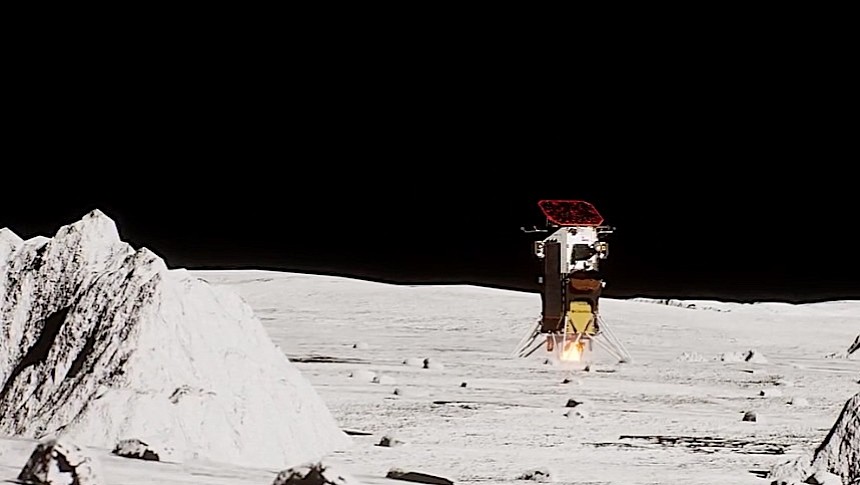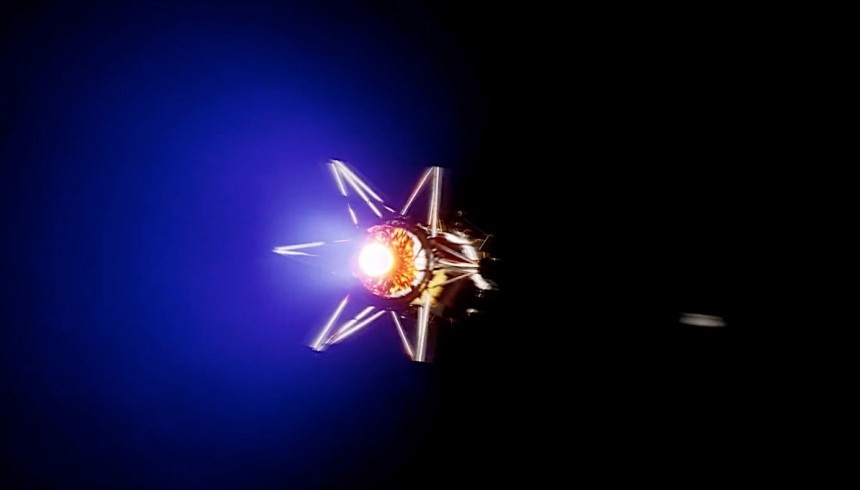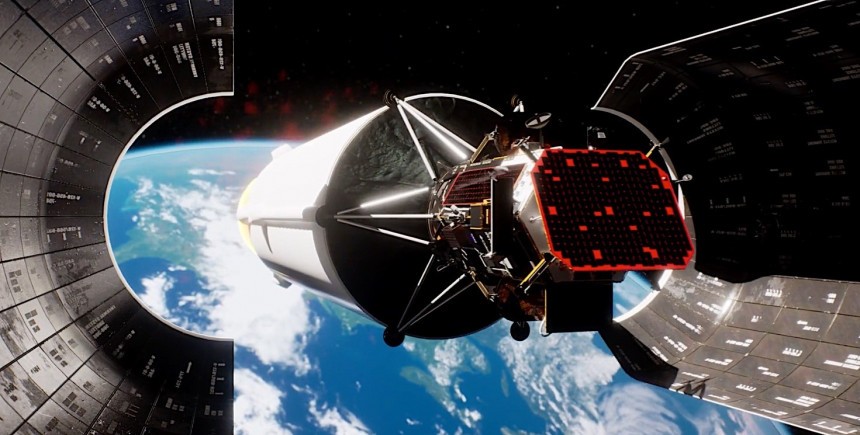A few months ago we brought you a story about something called the Goddard Image Analysis and Navigation Tool. GIANT, for short, is a tech that was already tested on the OSIRIS-REx mission and may forever change the way optical navigation in space is done. But how about navigation of the surface of alien worlds?
GIANT uses images snapped by cameras, lidar, and other sensors to find the best way forward for traveling spacecraft, a much-needed complement to the Deep Space Network antennas that are currently used for navigation in space.
The way the thing does things is rather simple: GIANT only needs a picture of the target to be able to determine the distance, the mass and center of a spinning object, and even identify landmarks on the surface of a celestial body. It can even be used to generate three-dimensional maps of potential landing zones.
But making your way through space is one thing, and doing the same on the surface of a celestial rock is an entirely different one.
Here on Earth, we navigate by means of satellites placed in orbit, sending data down to our devices, and we access it by means of various apps. Technically, the same thing can be done on other worlds as well, but sending to distant orbits enough satellites to make that possible may prove pretty expensive.
So NASA is betting on another kind of approach to solve the navigation needs of the humans that will live and work on the Moon and elsewhere in the not-so-distant future: lighthouses.
Lighthouses have always been beacons of hope for stranded sailors. Tall tower structures placed at the tips of landmasses, they use light to help ships make their way safely to land or to make it easier for the people on board to plot their next moves.
Up on the Moon the lighthouse idea the space agency is pondering will not use light, of course, but radio waves. And research on it is so advanced that we'll see it put to the test sooner than we think.
Come February, a SpaceX Falcon 9 will take off from Cape Canaveral in Florida, carrying with it a lunar lander called Nova-C. It's a product of private company Intuitive Machines, which is launching the mission as part of NASA's Commercial Lunar Payload Services (CLPS) program, the same one under which the failed Peregrine lunar lander launched.
Nova-C will be packed full of science, including six NASA-backed science experiments. One of these experiments is called Lunar Node-1, and it is essentially the precursor of the lighthouse system I mentioned earlier.
The thing is, in essence, a radio beacon. Its purpose is to "support precise geolocation and navigation observations" for all the gear we're about to send to the Moon in the coming years: landers, rovers, surface infrastructure, and even astronauts.
The tech uses a type of networked computer navigation software called Multi-spacecraft Autonomous Positioning System (MAPS), and it was put to the test back in 2018 on the International Space Station (ISS). It allows the Lunar Node-1 to digitally confirm the position of someone on the Moon in relation to other pieces of hardware present on the surface.
The first Lunar Node will be delivered to a lunar impact crater called Malapert A located at the Moon's South Pole. On the way there, it will send daily info back to Earth, just like what it will do once it touches down.
The exact way in which NASA will determine its effectiveness was not detailed, but it will clearly be a more effective and direct procedure than the way things are done today. Presently, NASA spacecraft and rovers navigate based on data captured on location, sent back to Earth to be processed, and then sent back to the vehicle that needs it. It is a process that works, but it may take a very long time.
If it works, the lighthouse idea could "change how human explorers, rovers, and spacecraft independently track their precise location on the Moon and in cis-lunar space." That's because the Lunar Node is not supposed to be a singular piece of hardware deployed up there, but form a network of such lighthouses that could help with navigation.
NASA compares such an extended system with metropolitan subway networks here on Earth, which allows us to know precisely where a train is, in real time.
The idea will be truly put to the test for the first time during the Intuitive Machines mission. The hardware will be tested for a duration of ten days, and after that we should know more accurately if there is merit to it.
If there is, NASA plans to make these lighthouses commonplace on the Moon. Anticipating success, the agency is already discussing with its corresponding entities in Europe and Japan to create an interconnected and interoperable navigation system for the Moon that will operate on the upcoming LunaNet standards.
The way the thing does things is rather simple: GIANT only needs a picture of the target to be able to determine the distance, the mass and center of a spinning object, and even identify landmarks on the surface of a celestial body. It can even be used to generate three-dimensional maps of potential landing zones.
But making your way through space is one thing, and doing the same on the surface of a celestial rock is an entirely different one.
Here on Earth, we navigate by means of satellites placed in orbit, sending data down to our devices, and we access it by means of various apps. Technically, the same thing can be done on other worlds as well, but sending to distant orbits enough satellites to make that possible may prove pretty expensive.
So NASA is betting on another kind of approach to solve the navigation needs of the humans that will live and work on the Moon and elsewhere in the not-so-distant future: lighthouses.
Lighthouses have always been beacons of hope for stranded sailors. Tall tower structures placed at the tips of landmasses, they use light to help ships make their way safely to land or to make it easier for the people on board to plot their next moves.
Come February, a SpaceX Falcon 9 will take off from Cape Canaveral in Florida, carrying with it a lunar lander called Nova-C. It's a product of private company Intuitive Machines, which is launching the mission as part of NASA's Commercial Lunar Payload Services (CLPS) program, the same one under which the failed Peregrine lunar lander launched.
Nova-C will be packed full of science, including six NASA-backed science experiments. One of these experiments is called Lunar Node-1, and it is essentially the precursor of the lighthouse system I mentioned earlier.
The thing is, in essence, a radio beacon. Its purpose is to "support precise geolocation and navigation observations" for all the gear we're about to send to the Moon in the coming years: landers, rovers, surface infrastructure, and even astronauts.
The tech uses a type of networked computer navigation software called Multi-spacecraft Autonomous Positioning System (MAPS), and it was put to the test back in 2018 on the International Space Station (ISS). It allows the Lunar Node-1 to digitally confirm the position of someone on the Moon in relation to other pieces of hardware present on the surface.
The first Lunar Node will be delivered to a lunar impact crater called Malapert A located at the Moon's South Pole. On the way there, it will send daily info back to Earth, just like what it will do once it touches down.
If it works, the lighthouse idea could "change how human explorers, rovers, and spacecraft independently track their precise location on the Moon and in cis-lunar space." That's because the Lunar Node is not supposed to be a singular piece of hardware deployed up there, but form a network of such lighthouses that could help with navigation.
NASA compares such an extended system with metropolitan subway networks here on Earth, which allows us to know precisely where a train is, in real time.
The idea will be truly put to the test for the first time during the Intuitive Machines mission. The hardware will be tested for a duration of ten days, and after that we should know more accurately if there is merit to it.
If there is, NASA plans to make these lighthouses commonplace on the Moon. Anticipating success, the agency is already discussing with its corresponding entities in Europe and Japan to create an interconnected and interoperable navigation system for the Moon that will operate on the upcoming LunaNet standards.











